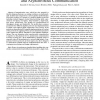Free Online Productivity Tools
i2Speak
i2Symbol
i2OCR
iTex2Img
iWeb2Print
iWeb2Shot
i2Type
iPdf2Split
iPdf2Merge
i2Bopomofo
i2Arabic
i2Style
i2Image
i2PDF
iLatex2Rtf
Sci2ools
TVLSI
2011
2011
Energy and Performance Models for Synchronous and Asynchronous Communication
—Communication costs, which have the potential to throttle design performance as scaling continues, are mathematically modeled and compared for various pipeline methodologies. First-order models are created for common pipeline protocols, including clocked flopped, clocked time-borrowing latch, asynchronous two-phase, four-phase, delay-insensitive, single-track, and source synchronous. The models are parameterized for throughput, energy, and bandwidth. The models share common parameters for different pipeline protocols and implementations to enable a fair apple-to-apple comparison. The accuracy of the models are demonstrated for complete implementations of a subset of the protocols by applying 65-nm process simulated parameter values against the SPICE simulation of full pipeline implementations. One can determine when asynchronous communication is superior at the physical level to synchronous communication in terms of energy for a given bandwidth by applying actual or expected values...
Related Content
| Added | 15 May 2011 |
| Updated | 15 May 2011 |
| Type | Journal |
| Year | 2011 |
| Where | TVLSI |
| Authors | Kenneth S. Stevens, Pankaj Golani, Peter A. Beerel |
Comments (0)

